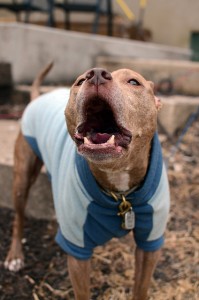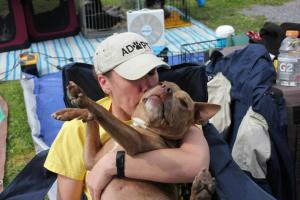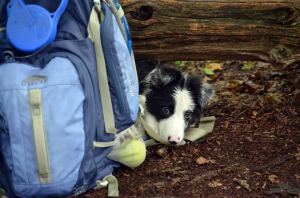I’ve been watching my young dog grow old for a while now, and I hate it. Luce was the first young dog I ever owned as an adult. I picked her out of the shelter based on her ridiculous ears and her serious expression. We took her into the “Getting to Know You” room and she dove snorting into my lap and then covered my face with kisses. I did not need to look further– I had found my dog.
She was never an easy dog. She was reactive, dog-aggressive, and incredibly energetic and athletic. If you turned her loose in a fenced yard, the first thing she’d do was check the fence for any sign of weakness, any loose boards. She was extremely smart and she used that power for naughtiness.
She was the first dog I ever trained, and she taught me so much. She taught me to think outside the box. She taught me that rewarding is more powerful than punishing. She taught me that even a crazy dog like her could learn to behave in public, even around other dogs.
She was the first dog I ever competed with, starting in Rally Obedience where she was on leash the entire time (and I very clearly remember telling my obedience instructor at the time that they could have my leash when they could pry it from my cold, dead hand). We quickly progressed to off-leash levels, and she kicked butt. She finished her career with a laundry list of titles after her name and a very proud mama.
That was years ago.
Now she’s twelve, arthritic, and senile.
Both of her knees are crunchy with arthritis and it’s hard for her to go up and down the stairs. She needs a boost to get into the car or onto my bed. But arthritis is something we can deal with, you know? There are plenty of medication options. There are joint supplements. And if those aren’t enough, there are things like cold laser therapy and acupuncture that might help. We have so many options for treating pain in dogs, so when our first medication choice didn’t do enough, we were able to switch to a second one that might work better.
But the senile part, that’s what I feel so helpless about. She barks and barks at me and I can’t figure out what she wants. She gets up and pees on the floor with no warning instead of asking to go out (and she doesn’t have an infection). She barks about everything. She never used to bark at all, even when the doorbell rang.
She goes off by herself when she used to be my shadow. She lays on the couch and doesn’t move all day.
And I question myself about whether she’s happy, about whether this is a good quality of life for her.I think she is happy, or at least content. She’s old and snoring the day away on a comfortable couch isn’t a bad deal. She loves her food and is happy to spend her time licking canned dog food out of a Kong. She can’t hear, but she can still snag a french fry out of the air without hesitation. She can’t handle hiking anymore, but she loves to go for car rides. She sits up all proud of herself in the front seat and knows that she’s important.
But I see the decline and it worries me whether or not I’ll be able to let go when it’s time, whatever that means. She’s my best friend and more than anything, I don’t want her to suffer. But nor can I imagine life without her. She has slept next to me in bed for 11 years. She has been my constant.
There are lots of suggestions on the internet about how to determine whether it is time to put your dog to sleep. Pick three things that your dog loves, and when she can’t do those things anymore, it’s time. But the things that Luce used to love to do have simply been replaced by things that she loves to do now. So how does that work? Some suggest that when your dog has more bad days than good days, it’s time. But what’s good and what’s bad and where do they equal out?
It’s so hard. I don’t want to be selfish. I don’t want her to suffer. But I don’t want to let her go before she’s ready.
Dr. Ron always says “decision of least regret”. And I believe that too early is better than too late. But why does it have to be so complicated?
Why does love have to be this hard?
The word “euthanasia” literally means “good death” and I am so grateful that we are able to give our pets this one last kindness. I am grateful that we can end suffering.
If you’re struggling with this with your own pet, please feel free to give us a call. Any of the staff would be happy to talk to you, and if you need more advice than what we can provide over the phone, we can always schedule your pet for a doctor visit. Sometimes a simple physical can lead to a clearer picture– if you’re thinking about putting your old dog to sleep because she is having trouble getting up, maybe pain medication will improve her quality of life. If your old cat is skinny and vomiting all over the place, perhaps he has a medical condition that we can treat. Or maybe it really is just time.
Every path is unique. Everybody’s answer is going to be different.
But we’re all doing it because we love them.
I know I’m not the only one out there who struggles with this– what has been helpful to you in making this hard decision? What are your tips?





 ons to adopting:
ons to adopting:



















